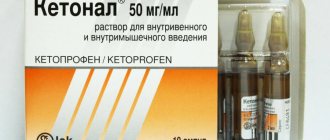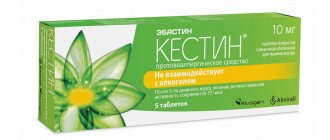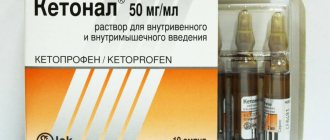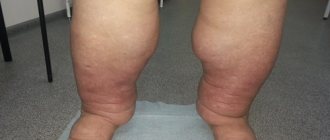Dosage forms and composition of Tramadol
The active component of the drug is Tramadol hydrochloride. This substance is an opioid agonist and acts on specific receptors in the central nervous system, inhibiting sensitivity to pain. Tramadol is considered an analgesic of mixed action. Available in several forms for local and systemic use:
- Tablets: white coated, scored, in dosages of 50, 100 mg. Packed in blisters, packaged in 10–100 pieces. Excipients in the composition: starch, silicon dioxide, magnesium stearate, MCC.
- Gelatin capsules: 50 mg each, yellowish in color, contain white powder inside the shell.
- Suspension for oral administration: clear sweetish liquid with mint and anise aroma, 1 ml - 100 mg of active ingredient, water, propylene glycol, glycerin, sucrose, flavorings, essential oils. Available in glass bottles
- Solution for injection: with a dosage of 50 mg Tramadol hydrochloride per 1 ml. Water-based, in glass ampoules 1–5 ml.
- Rectal suppositories: fat-based, white torpedo-shaped, packaged in cell blisters. Each suppository contains 100 mg of active substance.
Tramadol Retard tablets are also available with a dosage of up to 200 mg, which have a longer lasting effect.
Compatibility with other drugs
Taking Tramadol and pregabalin together may cause constipation. To avoid this, it is necessary to follow preventive measures against intestinal obstruction and constipation.
Simultaneous use of an opioid painkiller with Analgin and Ketorol leads to increased toxic effects (drugs cannot be mixed).
Ketonol should not be mixed with Tramadol to avoid side effects.
When dealing with moderate pain due to cancer, the combination Tramadol + Diphenhydramine (increases the analgesic effect) is excellent.
If a doctor prescribes Tramadol, the patient must completely stop drinking alcohol.
The simultaneous use of Tramadol and Morphine can lead to breathing problems and arterial hypotension.
Combining Phenazepam and Tramadol can lead to increased side effects.
Tramadol for toothache
Tramadol is a mixed action analgesic. For severe toothache, an opioid pain reliever will help.
However, when taking Tramadol, you should be sure to familiarize yourself with the possible side effects and follow the dosage.
When the opportunity arises, you should immediately contact your dentist.
Tramadol for cats and dogs
Veterinarians prescribe opioid pain medication to dogs and cats for severe pain or after surgery, cancer, or injury. In addition, Tramadol is used to relieve pain in older dogs.
Depending on the situation, the recommended dose of medication for dogs can vary from 1.1 mg/kg to 9.9 mg/kg. The medication can be taken orally every 8 hours.
The recommended single dosage for cats is 3 mg/kg, repeated dosage is allowed only after 8 hours.
How does Tramadol work?
The active substance of the drug, penetrating into the blood, binds to opioid receptors of various types in the brain and spinal cord. As a result, the production of pain neurotransmitters is reduced and the conductivity of neurons is inhibited. The intensity of painful sensations decreases, among other things, due to the effect of Tramadol on the receptors of the digestive tract.
- The drug inhibits the functioning of both cerebral hemispheres;
- has a calming effect;
- inhibits the cough reflex;
- affects the respiratory center.
The effect of use develops after 15–20 minutes and lasts up to 6 hours, depending on the intensity of the pain syndrome. The most effective dosage form is an injection solution. With prolonged use, the analgesic effect of Tramadol decreases, and the body requires a greater concentration of it.
The drug is metabolized in the liver tissues, part of it is excreted unchanged by the kidneys. The half-life of Tramadol can last up to 2 days or more in case of cholecystitis, hepatitis, hepatosis and other liver pathologies. The effect of the drug on the body continues.
Tramadol
Tramadol should not be used simultaneously with MAO inhibitors or within 2 weeks after their discontinuation.
With the simultaneous use of substances acting on the central nervous system (anaesthetics, antidepressants, antipsychotics, sedatives, anxiolytics, hypnotics) or with alcohol consumption, there is a possibility of a synergistic effect, manifested by excessive sedation and increased analgesic effect. Tramadol enhances the effect of drugs that depress the central nervous system and ethanol.
Inducers of microsomal oxidation (including carbamazepine, barbiturates) reduce the severity of the analgesic effect and duration of action. Due to the increased risk of seizures, the simultaneous use of carbamazepine and tramadol is not recommended. Long-term use of opioid analgesics or barbiturates stimulates the development of cross-tolerance.
Anxiolytics increase the severity of the analgesic effect; The duration of anesthesia increases when combined with barbiturates.
Naloxone activates respiration, eliminating analgesia after the use of opioid analgesics.
MAO inhibitors, furazolidone, procarbazine, antipsychotic drugs (neuroleptics) increase the risk of developing seizures (lowering the seizure threshold). Quinidine increases the plasma concentration of tramadol and reduces the Ml of the metabolite due to competitive inhibition of the CYP2D6 isoenzyme.
Inhibitors of the CYP2D6 isoenzyme (such as fluoxetine, paroxetine and amitriptyline) reduce the metabolism of tramadol.
Selective serotonin reuptake inhibitors (some antidepressants and drugs that reduce appetite), tricyclic antidepressants, other tricyclic compounds (for example, promethazine), anti-migraine drugs (triptans), narcotic analgesics, MAO inhibitors, antipsychotics and other drugs that reduce the threshold of convulsive readiness, increase the risk of developing seizures.
Selective serotonin reuptake inhibitors, serotonin and norepinephrine reuptake inhibitors, tricyclic antidepressants, MAO inhibitors, anti-migraine drugs (triptans) and drugs that interfere with the metabolism of tramadol (inhibitors of CYP2D6 and CYP3A4 isoenzymes), when used together with tramadol, can cause serotonin syndrome (confusion , agitation, hyperthermia, sweating, ataxia, hyperreflexia, myoclonus, diarrhea). Discontinuation of serotonergic drugs causes rapid relief of symptoms of serotonin syndrome.
Caution is required during simultaneous therapy with tramadol and coumarin derivatives (for example, warfarin), as there are reports of an increase in the international normalized ratio (INR) and the appearance of ecchymosis in some patients.
Pre- or postoperative use of an antiemetic drug, a 5-HT3-serotonin receptor antagonist, increases the need for tramadol in patients with postoperative pain syndrome.
When is Tramadol indicated?
The drug is used to reduce and eliminate pain of various origins:
- for physical injuries: dislocations, fractures, soft tissue ruptures, severe burns;
- consequences of surgical interventions;
- when performing invasive painful diagnostic procedures;
- in the later stages of malignant oncological tumors;
- after myocardial infarction;
- with neurological manifestations.
Injection forms of the drug, tablets, capsules and suppositories are approved for adults and children over 14 years of age. Tramadol drops can be used in patients from 1 year of age.
Addiction
Therapeutic doses of the drug usually do not cause pathological desire. However, a slight increase in dose leads to physical and psychological dependence.
As a result of regular use of the drug for 3 months, it becomes the only and “unique” drug for a person.
Physical cravings for the drug can be overcome, but fighting mental cravings requires patience and special efforts.
Even after detox therapy, Tramadol is not completely eliminated from the body.
In what cases is Tramadol prohibited?
The use of analgesics in all forms is excluded in case of individual intolerance to the active and auxiliary substances, alcohol abuse or poisoning, or dependence on psychoactive substances. Other contraindications:
- suicidal tendencies, severe clinical depression;
- renal and liver failure;
- undergoing treatment with certain psychotropic drugs;
- epilepsy that cannot be corrected with medications;
- first trimester of pregnancy.
In late pregnancy and lactation, Tramadol is prescribed in exceptional cases for individual indications.
Is Tramadol a drug?
At the initial stage of studying tramadol, it was recognized that pain relief occurs due to the participation of the opioid system, the medication was classified as a narcotic painkiller.
Trambadol
The small number of side effects is explained by the establishment of a mixed mechanism of action. In Russia, the analgesic is included in the group of vital and essential drugs.
Consequently, according to the current classification, Tramadol is not considered a narcotic substance, but is classified as a potent drug. The medication is not dispensed without a prescription from the attending physician.
Use in doses exceeding the therapeutic range contributes to the formation of dependence.
Side effects of Tramadol
While using the medication, dizziness, general lethargy, increased drowsiness, decreased appetite and nausea are possible. In rare cases, and after overdoses, the following develop:
- impaired coordination of movements;
- tachycardia;
- visual or auditory hallucinations;
- respiratory depression;
- vomiting, diarrhea;
- abdominal cramps;
- skin itching.
In case of intoxication with the drug, the following are possible: urinary retention, confusion or loss of consciousness, vascular collapse, convulsions. In women, long-term use may cause menstrual irregularities. It is typical that prolonged use of the drug leads to drug dependence.
How to relieve withdrawal symptoms from Tramadol
Dependence on Tramadol is very strong. Rapid withdrawal of the drug provokes the development of withdrawal symptoms.
Psychological symptoms of withdrawal:
- Hallucinations
- Aggressiveness
- Depression
- Hysterics
- Suicidal tendencies
The physical manifestations of withdrawal are the same as the side effects that occur when taking medications in high doses.
If withdrawal symptoms occur, it is better to seek help from a doctor. Detoxification will help relieve the painful symptoms of withdrawal.
The doctor will develop a schedule for stopping the medication and prescribe a diet. During treatment it is necessary to stop drinking alcohol.
How long does it stay in urine?
Metabolites of the drug remain in the urine for about a week. The half-life depends on the regularity of use of the analgesic and the presence of problems with the urinary system.
Tramadol for oncology
The medicine will be prescribed to cancer patients if pain does not decrease after using less toxic but highly effective painkillers. Long-term use of opiates risks addiction.
But in cancer patients in the terminal stage and with metastases, drug addiction is excluded.
How to use Tramadol: instructions
The drug is prescribed by a doctor in short courses as a symptomatic remedy. The regimen of use and dosage depend on the physical condition and age of the patients.
- Instructions for oral solution: patients over 14 years old - 20 drops with a spoon of sugar or water, 1 time per day. If necessary, it is allowed to repeat the dose after 1–2 hours. Children under 14 years of age: at the rate of 1 mg. per 1 kg. body weight.
- Tablets and capsules are taken with water, before or after meals. Daily dose: 50 mg. For severe pain, an increase to 400 mg is possible.
- Tramadol injections are given subcutaneously, intravenously or intramuscularly. Before administration, the contents of the ampoules are diluted in saline solution. Daily doses of the drug vary from 50 to 400 mg. Time intervals between injections: 4–6 hours.
- Suppositories are used rectally, introducing 1 piece. from 1 to 4 times a day.
Elderly people suffering from reduced liver or kidney function are recommended to reduce the dose of Tramadol by half.








